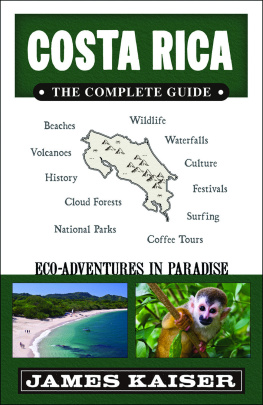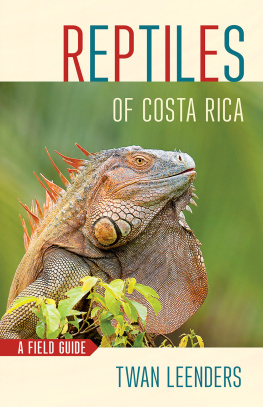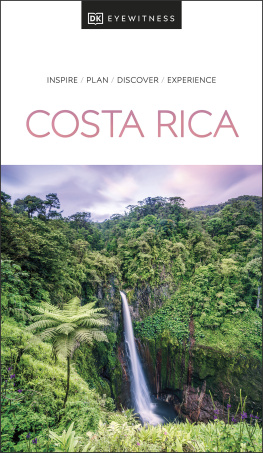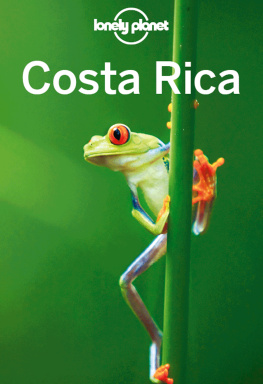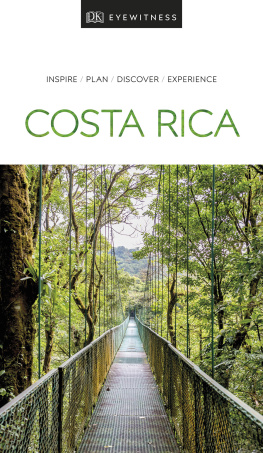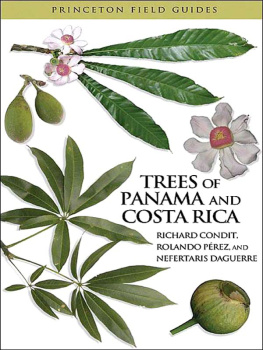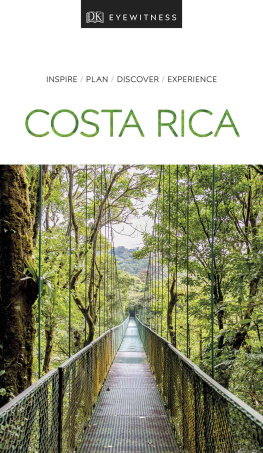ACKNOWLEDGMENTS
Writing this book has been a real labor of love. It represents the culmination of forty years of personal and professional relationships in Costa Rica. Special appreciation goes to my wife, Ethelle, and my son, Craig, who have traveled with me from Minnesota to Costa Rica many times and helped with everything from wildlife observations to editing and preparing the manuscript. In 1985, Karen Johnson, the owner of Preferred Adventures Ltd. in St. Paul, Minnesota, urged us to try leading a birding trip to Costa Rica. We finally agreed and led our first trip in 1987. It was the beginning of a wonderful experience that has enabled us to meet many special people in our tour groups as well as Costa Rican tourism outfitters, guides, and ecolodge staffs.
Michael Kaye, the owner of Costa Rica Expeditions, has been very supportive of this project and has coordinated our travel there. He facilitated travel to visit several sites for photography purposes, including Monteverde Lodge. Carlos Gmez Nieto is the extraordinary guide who has led all but one of our Costa Rican birding trips. Carlos is the premier birder in Costa Rica, and his vast knowledge of wildlife behavior and identification has helped us accumulate our wildlife records, which now exceed 27,000 observations. Manuel Salas and Marco Antonio Nio Morales have been the drivers for most of our trips and have been invaluable in spotting birds and in providing us with safe and memorable travel experiences.
Other people have helped with facilitating our travels and the collection of information and photos. They include Lisa and Kathy Erb at Rancho Naturalista; Don Efran Chacn, Rolando Chacn, and the rest of the Chacn family; Amos Bien of Rara Avis; Gail Hewson-Hull; Luis Diego Gmez; and the late Dr. Alexander Skutch and Pamela Skutch at Los Cusingos.
Biologists and scientists provided expertise on species identification and life history data, including Dr. Daniel Janzen, Dr. Graciela Candelas, Dr. Alexander Skutch, Dr. Frank T. Hovore, and Jorge Corrales of the Instituto Nacional de Biodiversidad (INBIO).
And finally, special appreciation goes to all the Costa Rican travelers who have accompanied us on our birding trips and provided the companionship, sharp eyes, and friendships that have enriched our lives.
APPENDICES
APPENDIX A: COSTA RICAN CONSERVATION ORGANIZATIONS
Asociacin Ornitolgica de Costa Rica: Apdo 2289-1002, San Jos, Costa Rica. E-mail: . Fax: 506-2278-1564.
Association for the Conservation of Nature (ASCONA): Apdo 83790-1000, San Jos, Costa Rica. Telephone: 506-2233-3188.
Birding Club of Costa Rica: Web newsletter Tico Tweeter reports on recent and upcoming birding trips and birding discoveries at various sites and lodges. E-mail: .
Caribbean Conservation Corporation: Gainesville, Florida. Telephone: 1-800-678-7853. Web site: www.cccturtle.org.
Corcovado Foundation: A nonprofit organization dedicated to protection of the rainforest and wildlife in Corcovado National Park, where there have been recent problems with poaching of endangered wildlife species. www.corcovadofoundation.org.
Costa Rica Birding Trail: A new effort in the northern region of Costa Rica to promote birding along a trail of lodges and protected areas that provide a stimulating variety of habitats. www.costaricanbirdroute.com.
Gone Birding: Information about birding and birding activities in Costa Rica, authored by expert birder Richard Garrigues. Google gone birding newsletter.
Great Green Macaw Research and Conservation Project: Cooperative project headed by the Tropical Science Center and dedicated to the protection and restoration of the Great Green Macaw in the Caribbean lowlands of Costa Rica. www.lapaverde.or.cr/lapa.
Henderson Birding: www.hendersonbirding.com. The authors Web site, where updates, new information, and corrections to the Field Guide to the Wildlife of Costa Rica will be posted. Includes Costa Rica birding information, trip tips, preparation checklist, and itineraries for future birding trips.
La Selva Biological Field Station, OTS: Apdo 53-3069, Puerto Viejo de Sarapiqu, Heredia, Costa Rica. Telephone: 506-2766-6565; e-mail: .
Las Cruces Biological Station and Wilson Botanical Garden, OTS: Apdo 73, 8257 San Vito, Coto Brus, Costa Rica. Telephone: 506-2773-4004; e-mail: .
Los Cusingos Neotropical Bird Sanctuary: The former home of Dr. Alexander Skutch, now managed by the Tropical Science Center. P.O. Box 8-3870-1000, San Jos, Costa Rica. Telephone: 506-2253-3276; e-mail: .
Monteverde Conservation League: Apdo 10165-1000, San Jos, Costa Rica. Manages the Childrens Eternal Rainforest. Telephone: 506-2645-5003; e-mail .
National Biodiversity Institute (INBIO): Apdo 22-3100, Santo Domingo, Heredia, Costa Rica. National organization dedicated to the creation of a comprehensive inventory of all of Costa Ricas plant and wildlife species; with biological collections now exceeding 3.5 million specimens and many excellent publications. Telephone: 506-2507-8100. www.inbio.ac.cr.
National Parks Foundation (Fundacin de Parques Nacionales): Apdo 236-1002, San Jos, Costa Rica. Telephone: 506-2222-4921 or 506-2223-8437.
Organization for Tropical Studies, Inc.: North American Headquarters, Box 90630, Durham, NC 27708-0630..
Rainforest Action Network: 221 Pine Street, Suite 500, San Francisco, CA 94104. Telephone: 415-398-4404. www.ran.org.
Rincn Rainforest: A protected tropical forest of 13,838 acres in .
Tirimbina Rainforest Center: A tropical science research and tourism center initiated by the Milwaukee Public Museum. Telephone: 506-2761-1579 or 506-2761-0055; e-mail: .
APPENDIX B: WILDLIFE TOURISM SITES AND FIELD STATIONS OF COSTA RICA
The wildlife tourism sites described here and portrayed in the map include 76 sites that have been visited by the author in Costa Rica, many of which are referred to in this book. In the following key, the site code from is followed by the name of the site, its biological zone and elevation, its coordinates, a brief description, and contact information. Abbreviations: BR, Biological Reserve. NP, National Park. NWR, National Wildlife Refuge. OTS, Organization for Tropical Studies. PAH, Pan American Highway.

Figure 11. Wildlife tourism sites referred to in the text and on species distribution maps. Prefixes to site numbers refer to the five biological zones outlined on the map: G, Guanacaste; S, Southern Pacific lowlands; H, Highlands; P, Central Plateau; and C, Caribbean lowlands.
GUANACASTE REGION
G-1: Los Inocentes Ranch: Tropical moist forest. Elev. 750. Lat. 1102.50N, long. 8530.00W. Address: P.O. Box 228-3000, Heredia, Costa Rica. This lodge is now closed to tourism.
G-2: Santa Rosa NP: Tropical dry forest/premontane moist forest. Elev. 1350. Lat. 1051.50N, long. 8536.50W. This park contains 181,186 acres and is an excellent example of tropical dry forest and premontane moist forest, as well as gallery forests. The Olive Ridley Turtle nesting beaches of Nancite are within this park. Telephone: Santa Rosa NP, 506-2666-5051; Guanacaste Conservation Area, 506-2666-4740.
G-3: Liberia, road to Tamarindo:


